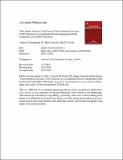Files in this item
Image analysis of the porous yttria-stabilized zirconia (YSZ) structure for a lanthanum ferrite-impregnated solid oxide fuel cell (SOFC) electrode
Item metadata
| dc.contributor.author | Ni, Chengsheng | |
| dc.contributor.author | Cassidy, Mark | |
| dc.contributor.author | Irvine, John T. S. | |
| dc.date.accessioned | 2019-08-21T23:40:07Z | |
| dc.date.available | 2019-08-21T23:40:07Z | |
| dc.date.issued | 2018-08-22 | |
| dc.identifier | 255552675 | |
| dc.identifier | 3cb63055-13da-4ce8-81eb-02e1aeea8c4d | |
| dc.identifier | 85052212385 | |
| dc.identifier | 000447117700024 | |
| dc.identifier.citation | Ni , C , Cassidy , M & Irvine , J T S 2018 , ' Image analysis of the porous yttria-stabilized zirconia (YSZ) structure for a lanthanum ferrite-impregnated solid oxide fuel cell (SOFC) electrode ' , Journal of the European Ceramic Society , vol. In press . https://doi.org/10.1016/j.jeurceramsoc.2018.08.026 | en |
| dc.identifier.issn | 0955-2219 | |
| dc.identifier.other | RIS: urn:19F61A49165E01BEC8495C3931237C2F | |
| dc.identifier.other | ORCID: /0000-0002-8394-3359/work/68280522 | |
| dc.identifier.uri | https://hdl.handle.net/10023/18351 | |
| dc.description | This research was also supported by the National Natural Science Foundation of China (NSFC, grant numbers 51702264; 41371275). C.N. also would like to thank the support from Fundamental Research Funds for the Central Universities (XDJK2017B033) and Research Funding of Southwest University (SWU117019). We would like to thank Engineering and Physical Sciences Research Council (EPSRC, UK, EP/P007821/1). | en |
| dc.description.abstract | Image analysis and quantification were performed on porous scaffolds for building SOFC cathodes using the two types of YSZ powders. The two powders (U1 and U2) showed different particle size distribution and sinterability at 1300 °C. AC impedance on symmetrical cells was used to evaluate the performance of the electrode impregnated with 35-wt.% La0.8Sr0.2FeO3. For example, at 700 °C, the electrode from U2 powder shows a polarization resistance (Rp) of 0.21 Ω cm2, and series resistance (Rs) of 8.5 Ω cm2 for an YSZ electrolyte of 2-mm thickness, lower than the electrode from U1 powder (0.25 Ω cm2 for Rp and 10 Ω cm2 for Rs) does. The quantitative study on image of the sintered scaffold indicates that U2 powder is better at producing architecture of high porosity or long triple phase boundary (TPB), which is attributed as the reason for the higher performance of the LSF-impregnated electrode. | |
| dc.format.extent | 1172071 | |
| dc.language.iso | eng | |
| dc.relation.ispartof | Journal of the European Ceramic Society | en |
| dc.subject | SOFC | en |
| dc.subject | Cathode | en |
| dc.subject | Image analysis | en |
| dc.subject | Infiltration | en |
| dc.subject | YSZ | en |
| dc.subject | QD Chemistry | en |
| dc.subject | NDAS | en |
| dc.subject.lcc | QD | en |
| dc.title | Image analysis of the porous yttria-stabilized zirconia (YSZ) structure for a lanthanum ferrite-impregnated solid oxide fuel cell (SOFC) electrode | en |
| dc.type | Journal article | en |
| dc.contributor.sponsor | EPSRC | en |
| dc.contributor.institution | University of St Andrews. School of Chemistry | en |
| dc.contributor.institution | University of St Andrews. EaSTCHEM | en |
| dc.identifier.doi | https://doi.org/10.1016/j.jeurceramsoc.2018.08.026 | |
| dc.description.status | Peer reviewed | en |
| dc.date.embargoedUntil | 2019-08-22 | |
| dc.identifier.grantnumber | EP/P007821/1 | en |
This item appears in the following Collection(s)
Items in the St Andrews Research Repository are protected by copyright, with all rights reserved, unless otherwise indicated.

